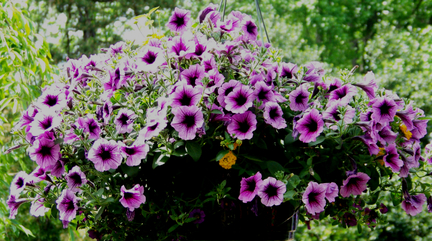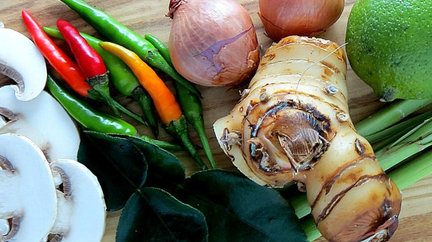Usually made with chicken meat, it is seasoned with lime juice, palm
sugar, lemongrass, makroot leaves, galangal (the kha of tom kha),
chiles, fish sauce, and cilantro. You can always distinguish a good tom
kha by the amount of coconut cream and galangal used in the soup;
the more of each used, the more expensive it is to produce, and the
better it tastes.
There are some amazingly vapid versions of tom kha produced in the
States, where little coconut milk and no coconut cream is used, and
the use of galangal is an afterthought. The more complex the soup is,
the more difficult it is to balance the seasonings so that they all contri-
bute to the whole, yet do not overshadow each other.
As with all Thai food, the major flavor components are present: hot,
sour, salty, sweet. It should taste creamy, rich, and spicy, with a faint
tart note from the lime, and some base saltiness from the fish sauce
on the finish.
______________________________________________________
Tom Kha Gai – Spicy Coconut and Galangal Soup with Chicken
serves 4 to 6
2 cups chicken stock
1 cup mushrooms, sliced ¼” (or canned straw mushroom equivalent)
8 Thai lime leaves, bruised to release flavor, central rib removed, torn
into pieces or julienned
6 2-inch pieces of lemongrass, bruised to release flavor
2 to 3-inch cube (or equivalent in frozen slices) galangal, sliced thinly
4 Tablespoons Thai fish sauce (Golden Boy or Tra Chang)
3 to 4 Tablespoons lime juice, to taste
2 teaspoons palm sugar, to taste
8 ounces chicken boneless thigh or breast, sliced thinly
2 13.5 ounce cans Chaokoh coconut milk, shaken
10 to 14 small red Thai chiles, crushed (or equivalent in nahm phrik
pao roasted chile paste: Sap’s Homemade available for sale at restau-
rant, or Mae Ploy brand ('Chilli in Oil'), or Butterfly Brand
Cilantro leaves, to garnish
Cooked jasmine rice, for service
______________________________________________________
Heat the stock, add the mushrooms, lime leaves, lemongrass, galangal,
fish sauce, lime juice, and palm sugar. Stir thoroughly, bring to a boil,
and add the coconut milk, and then the chile peppers. Bring back to
the boil, lower the heat to a simmer and cook for about 5 minutes to
allow the flavors to develop. Bring back just to the boil, stir in the
chicken slices, and immediately turn off the heat. Portion into thick
bowls, garnish each with cilantro leaves, and serve with jasmine rice
on the side.
______________________________________________________
NOTE
This soup is not intended to be eaten over the rice, or for the rice to
be mixed into the soup (except at the very end, to absorb every drop
of the broth), but to eat the soup separately, with bites of rice inter-
spersed. The soup can be made with seafood of any kind, especially
shellfish, instead of the chicken (pork or beef can be substituted as
well). If using chicken meat, boneless thigh meat is preferred, since
it has more flavor and will stay juicier. It can also be made with tofu,
preferably cubes of crispy fried tofu, which can be purchased pre-
cooked at Asian markets. Another substitute for the chicken is sliced
cooked artichoke hearts, which serve as a substitute for banana blossoms.






 Visit the website: Its About Thyme
Visit the website: Its About Thyme